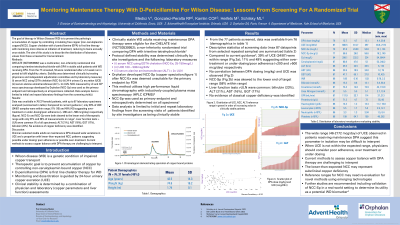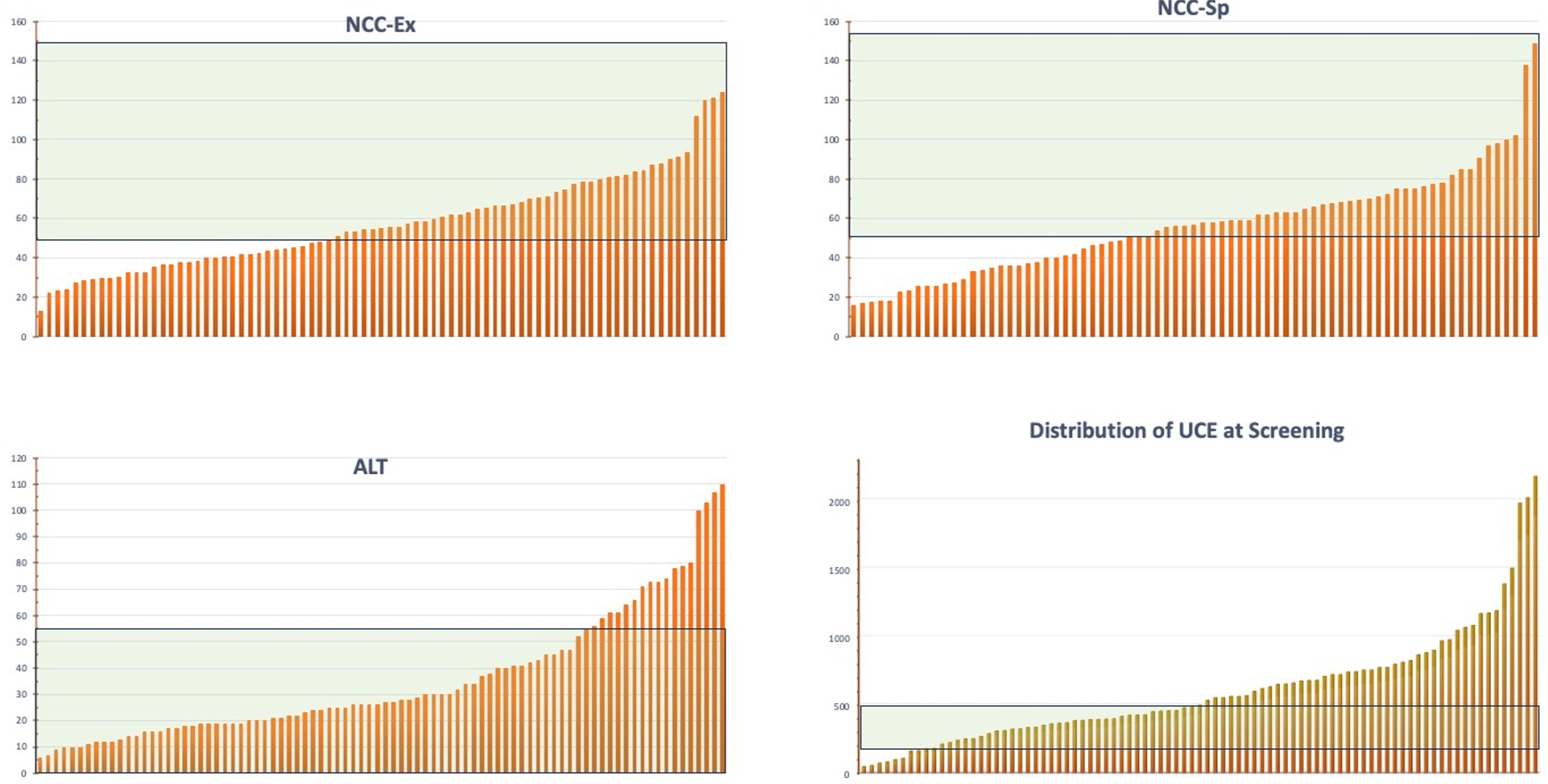Tuesday Poster Session
Category: Liver
P3803 - Lessons in Monitoring Chelation Therapy in “Stable” Wilson Disease Patients Screened for a Randomized Trial
Tuesday, October 24, 2023
10:30 AM - 4:00 PM PT
Location: Exhibit Hall

Has Audio

Valentina Medici
University of California Davis
Sacramento, CA
Presenting Author(s)
Valentina Medici, 1, Reginald Gonzales Peralta, MD2, C.Omar F. Kamlin, MD, FRCPC3, Michael Heifets, MD4, Michael L. Schilsky, MD5
1University of California Davis, Sacramento, CA; 2AdventHealth for Children, Orlando, FL; 3Orphalan, London, England, United Kingdom; 4Orphalan, Chicago, IL; 5Yale University Medical Center, New Haven, CT
Introduction: The goal of therapy in Wilson Disease (WD) is to prevent the pathologic accumulation of copper by controlling circulating free copper [non-ceruloplasmin copper;(NCC)]. Copper chelation with d-penicillamine (DPA) is first line therapy with monitoring more intense at initiation of treament, reducing to twice annually once stable. The aim of this study is to describe the distribution of laboratory values from those screened for trial enrolment.
Methods: CHELATE (NCT03539952) was a multicenter, non-inferiority randomized trial comparing trientine tetrahydrochloride with DPA in stable adult patients with WD receiving DPA. From the 77 screened, 53 were randomized after a 12-week run in period to fulfil eligibility criteria. Stability was determined clinically by treating physicians and independent adjudication committee and by laboratory measures; (i) serum NCC using EDTA chelation (NCC-Ex) (ii) 24-h urinary Cu excretion (UCE) (iii) serum alanine aminotransferase (ALT) < 2x ULN. NCC measured by chromatography and ICP mass spectroscopy developed by Orphalan (NCC-Sp) was used as the primary endpoint and retrospectively on all specimens collected. Data analysis here is limited to initial and repeat laboratory findings from the screening visit(s).
Results: Data was available in 76 (37 female) patients, with up to 87 laboratory specimens analysed (summarized in table). Compared to current guidance1, only 39% of UCE (34/87) samples were within range;11% (10) and 49% (43) suggesting over-treatment or under-dosing/poor adherence (< 200 and > 500 mcg/day) respectively (figure). NCC-Ex and NCC-Sp were both skewed to the lower end of therapeutic range with only 57% and 58% of measurements in range1. Synthetic liver function tests > ULN were common (% of all specimens); ALT (21%), AST (16%), GGT (17%), bilirubin (23%). No evidence of copper deficiency was identified.
Discussion: Clinician selected stable adults with WD on maintenance DPA showed wide variations in UCE and a proportion with lower-than-expected NCC; patterns suggesting possible under dosing/ poor adherence or possible over-treatment. Current methods to assess copper balance with DPA therapy are challenging to interpret. Further studies comparing [or correlating] clinical signs, symptoms, transient elastography, and novel biomarkers with accurate laboratory measures of copper balance are needed to guide therapeutic dosing to help with clinical optimization and guide future intervention trials.
1. Schilksy, ML., et al. 2023 Hepatology 77(4)

Disclosures:
Valentina Medici, 1, Reginald Gonzales Peralta, MD2, C.Omar F. Kamlin, MD, FRCPC3, Michael Heifets, MD4, Michael L. Schilsky, MD5. P3803 - Lessons in Monitoring Chelation Therapy in “Stable” Wilson Disease Patients Screened for a Randomized Trial, ACG 2023 Annual Scientific Meeting Abstracts. Vancouver, BC, Canada: American College of Gastroenterology.
1University of California Davis, Sacramento, CA; 2AdventHealth for Children, Orlando, FL; 3Orphalan, London, England, United Kingdom; 4Orphalan, Chicago, IL; 5Yale University Medical Center, New Haven, CT
Introduction: The goal of therapy in Wilson Disease (WD) is to prevent the pathologic accumulation of copper by controlling circulating free copper [non-ceruloplasmin copper;(NCC)]. Copper chelation with d-penicillamine (DPA) is first line therapy with monitoring more intense at initiation of treament, reducing to twice annually once stable. The aim of this study is to describe the distribution of laboratory values from those screened for trial enrolment.
Methods: CHELATE (NCT03539952) was a multicenter, non-inferiority randomized trial comparing trientine tetrahydrochloride with DPA in stable adult patients with WD receiving DPA. From the 77 screened, 53 were randomized after a 12-week run in period to fulfil eligibility criteria. Stability was determined clinically by treating physicians and independent adjudication committee and by laboratory measures; (i) serum NCC using EDTA chelation (NCC-Ex) (ii) 24-h urinary Cu excretion (UCE) (iii) serum alanine aminotransferase (ALT) < 2x ULN. NCC measured by chromatography and ICP mass spectroscopy developed by Orphalan (NCC-Sp) was used as the primary endpoint and retrospectively on all specimens collected. Data analysis here is limited to initial and repeat laboratory findings from the screening visit(s).
Results: Data was available in 76 (37 female) patients, with up to 87 laboratory specimens analysed (summarized in table). Compared to current guidance1, only 39% of UCE (34/87) samples were within range;11% (10) and 49% (43) suggesting over-treatment or under-dosing/poor adherence (< 200 and > 500 mcg/day) respectively (figure). NCC-Ex and NCC-Sp were both skewed to the lower end of therapeutic range with only 57% and 58% of measurements in range1. Synthetic liver function tests > ULN were common (% of all specimens); ALT (21%), AST (16%), GGT (17%), bilirubin (23%). No evidence of copper deficiency was identified.
Discussion: Clinician selected stable adults with WD on maintenance DPA showed wide variations in UCE and a proportion with lower-than-expected NCC; patterns suggesting possible under dosing/ poor adherence or possible over-treatment. Current methods to assess copper balance with DPA therapy are challenging to interpret. Further studies comparing [or correlating] clinical signs, symptoms, transient elastography, and novel biomarkers with accurate laboratory measures of copper balance are needed to guide therapeutic dosing to help with clinical optimization and guide future intervention trials.
1. Schilksy, ML., et al. 2023 Hepatology 77(4)

Figure: Screening Laboratory Measures of NCC-Ex, NCC-Sp, ALT and 24 hour UCE From Adults with WD Selected by Physicians and Considered Stable.
Normal or recommended therapeutic range are highlighted in light green.
Normal or recommended therapeutic range are highlighted in light green.
Disclosures:
Valentina Medici: Arbormed – Advisory Committee/Board Member. Arbormed – Grant/Research Support. Oprhalan – Advisory Committee/Board Member. Orphalan – site PI. Ultragenix – site PI. Vivet – Site PI.
Reginald Gonzales Peralta: Abbvie – Grant/Research Support. Albireo – Consultant, Speakers Bureau. Gilead – Grant/Research Support. Merck – Grant/Research Support. Mirum Pharmaceuticals – Consultant, Grant/Research Support, Speakers Bureau.
C.Omar Kamlin: Orphalan – Employee.
Michael Heifets: Orphalan – Employee.
Michael Schilsky: Alexion – Grant/Research Support. Medscape – Speakers Bureau. Orphalan – Grant/Research Support, Speakers Bureau. Vivet Therapeutics – Grant/Research Support. Wilson Disease Association – Grant/Research Support.
Valentina Medici, 1, Reginald Gonzales Peralta, MD2, C.Omar F. Kamlin, MD, FRCPC3, Michael Heifets, MD4, Michael L. Schilsky, MD5. P3803 - Lessons in Monitoring Chelation Therapy in “Stable” Wilson Disease Patients Screened for a Randomized Trial, ACG 2023 Annual Scientific Meeting Abstracts. Vancouver, BC, Canada: American College of Gastroenterology.
